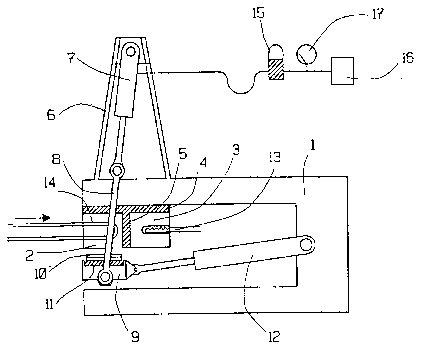Some of the information on this Web page has been provided by external sources. The Government of Canada is not responsible for the accuracy, reliability or currency of the information supplied by external sources. Users wishing to rely upon this information should consult directly with the source of the information. Content provided by external sources is not subject to official languages, privacy and accessibility requirements.
Any discrepancies in the text and image of the Claims and Abstract are due to differing posting times. Text of the Claims and Abstract are posted:
| (12) Patent Application: | (11) CA 2192059 |
|---|---|
| (54) English Title: | A DEVICE FOR PRESSING PLASTICS |
| (54) French Title: | DISPOSITIF DE PRESSAGE DE PLASTIQUES |
| Status: | Deemed Abandoned and Beyond the Period of Reinstatement - Pending Response to Notice of Disregarded Communication |
| (51) International Patent Classification (IPC): |
|
|---|---|
| (72) Inventors : |
|
| (73) Owners : |
|
| (71) Applicants : |
|
| (74) Agent: | MARKS & CLERK |
| (74) Associate agent: | |
| (45) Issued: | |
| (86) PCT Filing Date: | 1995-06-08 |
| (87) Open to Public Inspection: | 1995-12-21 |
| Availability of licence: | N/A |
| Dedicated to the Public: | N/A |
| (25) Language of filing: | English |
| Patent Cooperation Treaty (PCT): | Yes |
|---|---|
| (86) PCT Filing Number: | PCT/SE1995/000687 |
| (87) International Publication Number: | WO 1995034419 |
| (85) National Entry: | 1996-12-04 |
| (30) Application Priority Data: | ||||||
|---|---|---|---|---|---|---|
|
The present invention relates to plastic pressing apparatus comprising a press
tool which is adapted to be pressed against a thermostat-controlled heated or
cooled press surface with the aid of pressure means. According to the
invention, the press surface includes a flat surface which is common to a
thermostat-controlled cold device (2) and a thermostat-controlled hot device
(3), and the tool (10) can be moved from one thermostat-controlled device (2)
to the other thermostat-controlled device (3) with the invention of varying or
modifying the temperature of the tool (10) and the plastic workpiece enclosed
therein quickly and at the same time as the pressure is applied.
L'invention concerne un appareil de pressage de plastiques comprenant un outil de pressage destiné à être pressé contre une surface de pressage chauffée ou refroidie et régulée par thermostat, à l'aide d'un moyen de pression. La surface de pressage comporte une surface plane commune à un dispositif froid régulé par thermostat (2) et à un dispositif chaud régulé par thermostat (3), et l'outil (10) peut être déplacé d'un dispositif régulé par thermostat (2) à l'autre dispositif régulé par thermostat (3), l'invention permettant de modifier rapidement la température de l'outil (10) et de la pièce de plastique qu'il contient, et ce en même temps que la pression est appliquée.
Note: Claims are shown in the official language in which they were submitted.
Note: Descriptions are shown in the official language in which they were submitted.

2024-08-01:As part of the Next Generation Patents (NGP) transition, the Canadian Patents Database (CPD) now contains a more detailed Event History, which replicates the Event Log of our new back-office solution.
Please note that "Inactive:" events refers to events no longer in use in our new back-office solution.
For a clearer understanding of the status of the application/patent presented on this page, the site Disclaimer , as well as the definitions for Patent , Event History , Maintenance Fee and Payment History should be consulted.
| Description | Date |
|---|---|
| Inactive: IPC from MCD | 2006-03-12 |
| Time Limit for Reversal Expired | 2003-06-09 |
| Application Not Reinstated by Deadline | 2003-06-09 |
| Inactive: Status info is complete as of Log entry date | 2002-07-23 |
| Inactive: Abandon-RFE+Late fee unpaid-Correspondence sent | 2002-06-10 |
| Deemed Abandoned - Failure to Respond to Maintenance Fee Notice | 2002-06-10 |
| Application Published (Open to Public Inspection) | 1995-12-21 |
| Abandonment Date | Reason | Reinstatement Date |
|---|---|---|
| 2002-06-10 |
The last payment was received on 2001-05-29
Note : If the full payment has not been received on or before the date indicated, a further fee may be required which may be one of the following
Please refer to the CIPO Patent Fees web page to see all current fee amounts.
| Fee Type | Anniversary Year | Due Date | Paid Date |
|---|---|---|---|
| MF (application, 3rd anniv.) - standard | 03 | 1998-06-08 | 1998-06-03 |
| MF (application, 4th anniv.) - standard | 04 | 1999-06-08 | 1999-05-31 |
| MF (application, 5th anniv.) - standard | 05 | 2000-06-08 | 2000-05-30 |
| MF (application, 6th anniv.) - standard | 06 | 2001-06-08 | 2001-05-29 |
Note: Records showing the ownership history in alphabetical order.
| Current Owners on Record |
|---|
| TELEFONAKTIEBOLAGET LM ERICSSON |
| Past Owners on Record |
|---|
| KARL-ERIK LEEB |